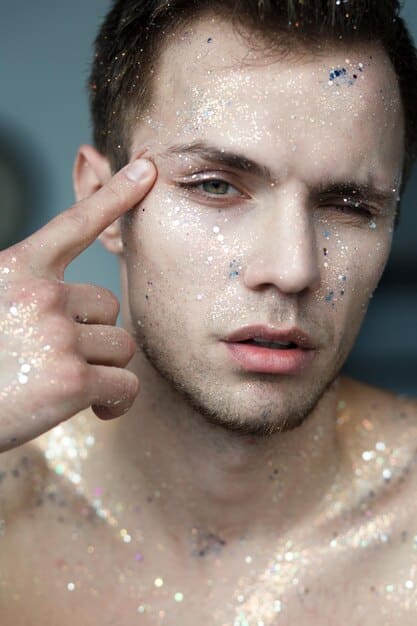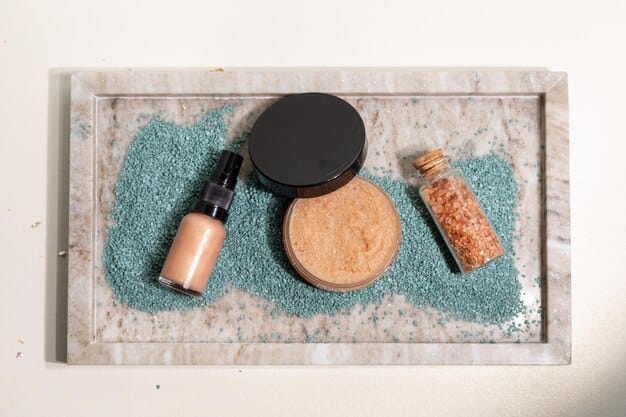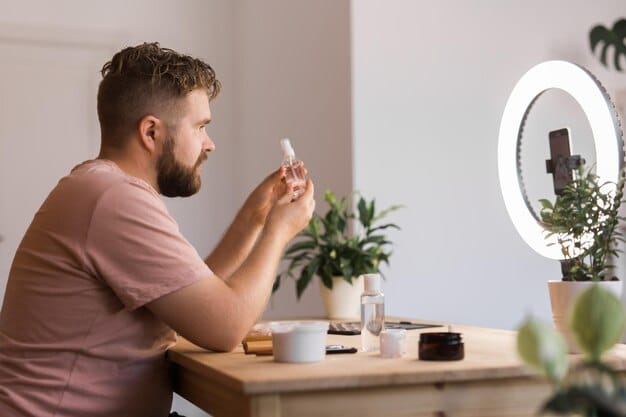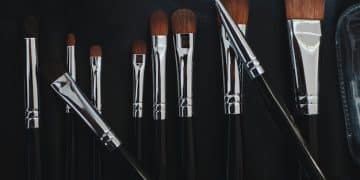Prevent Caked Makeup on Dry Skin: Men’s Guide

Achieving a natural, flawless makeup finish on dry skin requires a strategic approach focused on hydration, proper product selection, and meticulous application techniques, crucial for men seeking to avoid a caked appearance.
For men embracing makeup, one common challenge often emerges: the dreaded caked look, especially prevalent on dry skin. It’s a concern that transcends gender, yet for men, navigating the world of cosmetic application while maintaining a natural, confident appearance can feel particularly daunting. Understanding how to prevent makeup from caking: a guide for men with dry skin is not just about aesthetics; it’s about comfort, confidence, and ensuring your skin looks its best, not simply covered. This comprehensive guide will delve into the nuanced strategies and product choices essential for men with dry skin to achieve a smooth, undetectable makeup finish, empowering you to integrate cosmetics seamlessly into your grooming routine.
Understanding dry skin’s unique challenges with makeup
Dry skin presents a distinctive set of challenges when it comes to makeup application, particularly for men who might be new to this grooming aspect. Unlike oily or combination skin types, dry skin often lacks sufficient moisture and natural oils, leading to a complexion that can feel tight, appear flaky, and potentially react poorly to certain makeup formulations. These characteristics make it a prime candidate for makeup caking if not properly managed, as products tend to cling to dry patches and accentuate texture rather than blend seamlessly.
The fundamental issue lies in the skin’s barrier function. When this barrier is compromised due to dryness, moisture evaporates more quickly, leaving the skin dehydrated. Makeup, especially foundations and concealers, can then settle into fine lines or dry areas, creating an uneven, “caked-on” appearance that’s anything but discreet. For men, who may prefer a subtle enhancement over full coverage, a caked finish defeats the purpose entirely, drawing unwanted attention rather than providing a natural glow or evening out skin tone.
Hydration: the non-negotiable first step
Effective hydration is the bedrock of preventing makeup caking on dry skin. It’s not merely about applying a moisturizer; it’s about a multi-layered approach that prepares the skin to receive makeup as a smooth, well-conditioned canvas. Think of your skin like a sponge: a dry sponge will absorb product unevenly, leading to patchiness, while a damp sponge distributes it smoothly.
Starting with a diligently hydrated base ensures that makeup products glide on effortlessly and meld with the skin, rather than sitting on top of dry flakes. This initial step primes the skin, making it supple and receptive to subsequent layers, significantly reducing the likelihood of a caked-on effect. Without proper hydration, even the most expensive and well-formulated makeup can look unnatural and emphasize dryness.
- Cleanse with a gentle, hydrating cleanser that won’t strip natural oils.
- Apply a humectant-rich toner or essence to attract and lock in moisture.
- Use a deeply moisturizing serum with ingredients like hyaluronic acid or glycerin.
Choosing the right moisturizer and primer
The selection of your moisturizer and primer is paramount. For dry skin, opt for thick, occlusive moisturizers that create a barrier to prevent moisture loss. Look for ingredients like ceramides, squalane, shea butter, or rich plant oils. Apply it generously to damp skin to trap existing moisture, allowing it to fully absorb before moving to the next step. A well-moisturized face feels comfortable and looks plump, providing the ideal foundation for makeup.
Following moisturizer, a hydrating primer is invaluable. Unlike mattifying primers designed for oily skin, a hydrating primer creates a smooth, dewy surface that helps makeup adhere evenly and prolongs wear without drying. Many hydrating primers also contain emollients and humectants, further boosting the skin’s moisture levels and improving makeup’s overall appearance. This dual-action approach ensures maximum adherence and a seamless finish, making it easier to blend products and avoid the common pitfalls of dry skin makeup.
Proper moisturization, coupled with the right primer, ensures that your skin is adequately prepared, making makeup application less of a struggle and more of a fluid process. This preparatory work is often overlooked, yet it stands as the most critical defense against the caked appearance, providing a durable, hydrated base for all subsequent products.
Product selection: formulas that love dry skin
The type of makeup products you choose plays a pivotal role in preventing caking on dry skin. Not all formulations are created equal, particularly when addressing the specific needs of skin that lacks moisture. For men seeking a natural, un-caked look, understanding which products to favor and which to avoid is crucial. The goal is to select items that provide coverage while simultaneously offering hydration and a seamless finish, melting into the skin rather than sitting on its surface.
Foundation and concealer: hydrators are key
When it comes to foundation and concealer, men with dry skin should gravitate towards formulas specifically designed for hydration. Avoid matte, full-coverage products, as these are often formulated to absorb oil and can exacerbate dryness, settling into fine lines and flaky patches. Instead, look for liquid or cream foundations and concealers that offer light to medium coverage with a luminous, dewy, or satin finish. These textures are typically infused with moisturizing ingredients that help them glide smoothly and blur imperfections without accentuating dryness.
Words like “hydrating,” “luminous,” “dewy,” “skin tint,” or “serum foundation” are good indicators. Ingredients such as hyaluronic acid, glycerin, squalane, and various natural oils are excellent additions. These components ensure the product blends effortlessly, providing a natural, skin-like finish that moves with your face rather than cracking or settling. For men, a tinted moisturizer or a BB/CC cream can be an excellent starting point, offering light coverage and significant hydration, making them almost foolproof to apply without caking.
- Opt for liquid or cream formulas over powders.
- Look for “hydrating,” “luminous,” or “serum” descriptions.
- Check ingredient lists for humectants and emollients.
Powder: use sparingly, if at all
Powder is often the primary culprit behind a caked makeup look, especially on dry skin. Its purpose is typically to set liquid products and control shine, but for dry skin, this can lead to an overly matte, chalky, and textured appearance. If you must use powder, do so with extreme caution and moderation. Opt for finely milled, translucent setting powders rather than opaque, mattifying options. Apply only to areas where absolutely necessary, such as lightly under the eyes to set concealer or around the nose if there’s any residual shine, which is rare for dry skin.
A fluffy brush should be used for application, rather than a puff, to ensure the lightest possible dusting. The aim is to lightly “kiss” the skin with powder, not to build up a visible layer. Many men with dry skin find they can skip powder altogether, preferring the natural, slightly dewy finish of liquid products. This minimalist approach often yields the most natural-looking results, ensuring your skin maintains its healthy luster without appearing overly made-up or dry.

Setting sprays: your dry skin’s best friend
While powder can be problematic, a hydrating setting spray is a game-changer for men with dry skin. Unlike traditional setting sprays that can be alcohol-heavy and drying, hydrating setting sprays are formulated to infuse moisture back into the skin and melt makeup seamlessly together, eliminating any powdery finish. They help to fuse all layers of makeup, making it look like a second skin rather than distinct layers of product.
After completing your makeup application, a generous mist of a hydrating setting spray can refresh your complexion, add a natural dewiness, and significantly improve the longevity of your makeup without stiffness. Look for sprays containing ingredients like glycerin, hyaluronic acid, or plant extracts. These sprays not only set your makeup but also keep your dry skin feeling comfortable and looking fresh throughout the day, ensuring there’s no visible caking as the hours pass. This final step is crucial for achieving that coveted “skin-like” finish, maintaining integrity and comfort.
Application techniques for a flawless finish
Beyond choosing the right products, the technique you employ in applying makeup is paramount in preventing caking, particularly on dry skin. Even the most hydrating formulas can look heavy or uneven if not applied with a mindful, light hand. For men, who typically aim for a subtle enhancement, mastering these techniques ensures that makeup looks like natural, improved skin, not a mask.
Less is more: the cardinal rule
The most crucial principle for men applying makeup on dry skin is “less is more.” This isn’t just a suggestion; it’s a fundamental rule. Applying too much product, especially foundation or concealer, is the quickest way to achieve a caked finish. Dry skin tends to absorb product unevenly and can’t effectively “hold” thick layers without looking heavy. Instead of layering on product to cover imperfections, focus on strategic, thin applications.
Start with a minimal amount of product and build coverage only where genuinely needed. For many men, this might mean a light touch of tinted moisturizer all over, possibly followed by a targeted dot of concealer on a specific blemish or area of discoloration. The goal is to let your natural skin show through as much as possible, enhancing rather than obscuring. This also prevents product from settling into fine lines or dry patches, leading to a much smoother, more undetectable result.
Application tools and methods
The tools and methods you use to apply makeup significantly impact the final finish. For dry skin, certain tools are more forgiving and help achieve a seamless blend. Fingers or damp beauty sponges are often preferred over dense brushes for liquid and cream products.
- Fingers: The warmth of your fingertips helps to melt the product into the skin, ensuring a natural blend. This method is particularly effective for tinted moisturizers, BB/CC creams, and cream concealers. Pat and press the product into the skin rather than rubbing, which can disturb dry patches.
- Damp Beauty Sponge: A damp beauty sponge (like a Beautyblender) provides an airbrushed finish by gently pressing product into the skin, distributing it evenly without absorbing too much. The dampness helps to hydrate the skin briefly during application and prevents product from clinging to dry areas. Use a bouncing or stippling motion for best results.
- Soft Brushes: If using a brush, opt for a soft, fluffy foundation brush that doesn’t drag on the skin. Stippling brushes are also excellent as they apply product by dabbing, which can help blend without disturbing dry flakes.
Regardless of the tool, remember to use gentle, pressing motions. Avoid swiping or rubbing, which can create streaks or lift existing products, resulting in a patchy, caked look. Focus on blending outwards from the center of the face, where coverage is typically needed most, feathering the edges so there are no harsh lines.
Layering and setting strategically
Strategic layering is key to preventing caking. Instead of applying all your base products at once, allow each layer to settle and absorb for a minute or two before adding the next. This prevents products from pilling or becoming a thick, unblended mess. For example, apply your moisturizer, wait, then primer, wait, then foundation, and finally concealer. This methodical approach ensures each product integrates properly with the skin.
When setting, as previously mentioned, keep powder use minimal. For many men with dry skin, a hydrating setting spray is ample for locking makeup in place without adding texture or dryness. If you do use powder, remember to press it gently into the skin using a fluffy brush, only in areas that really need it, like the T-zone if you happen to get a bit oily there (uncommon for dry skin, but possible). Avoid large areas of the face like the cheeks or forehead unless absolutely necessary. This smart approach to layering and setting ensures your makeup remains seamless and natural throughout the day.
Maintenance and touch-ups throughout the day
Preventing makeup from caking isn’t just about the initial application; it also involves mindful maintenance and strategic touch-ups throughout the day. Dry skin can continue to dehydrate, especially in environments with low humidity or due to natural skin processes, which can cause makeup to settle or look less fresh. For men aiming for a consistently natural appearance, understanding how to refresh their look without adding more product is essential.
Mid-day hydration boost
One of the most effective ways to combat potential caking as the day progresses on dry skin is to reintroduce moisture. This doesn’t mean reapplying foundation. Instead, carry a facial mist or hydrating setting spray with you. A quick spritz can instantly refresh your complexion, rehydrate the skin, and meld any makeup that might have started to look powdery or settled into lines.
The fine mist helps “wake up” the makeup, making it look as if it was just applied. Look for mists that are alcohol-free and contain humectants like glycerin or rosewater. A few sprays from about 8-12 inches away, followed by gentle air drying or a light tap with clean fingers, can revive your look. This technique not only prevents caking but also provides a soothing sensation for dry skin, preventing it from feeling tight or uncomfortable. It’s a discreet way to keep your skin looking fresh and your makeup natural.
Blotting vs. refreshing
For men with dry skin, the concept of “blotting” needs to be approached differently than for those with oily skin. Traditional blotting papers absorb oil, which dry skin lacks. Instead of blotting away shine (which you likely won’t have), focus on refreshing. If your skin feels a bit tight or your makeup seems to be clinging to dry spots, a moisturizing mist is your best friend. Blotting dry skin can actually exacerbate the problem by removing any remaining light moisture or product, making it look drier.
If you genuinely notice any slight creasing, especially under the eyes, gently pat the area with a clean fingertip or a tiny bit of your hydrating setting spray on a damp beauty sponge. The key is to re-blend and re-hydrate without adding more makeup. Your goal is to smooth out any areas where product might have settled, returning it to a seamless finish without adding extra layers that could lead to caking.
Strategic touch-ups for dry patches
If, despite your best efforts, a dry patch becomes visible or makeup starts to cling to a specific area, resist the urge to apply more foundation directly on top. This will almost certainly lead to caking. Instead, consider this two-step process:
- Hydrate the patch: Apply a tiny dab of eye cream or a hydrating balm to the dry area with a clean finger. Gently pat it into the skin, allowing it to absorb and re-plump the dry patch.
- Re-blend very gently: Once the area is hydrated, use a clean, damp beauty sponge or your fingertip to very gently pat and blend the existing makeup around the rehydrated patch. The idea is to smooth out the existing product, rather than layering on new product.
This method ensures you address the root cause (dryness) while correcting the makeup issue. Always use a light hand, and remember that minor imperfections are often more natural than a heavily re-applied, caked finish. For men, the goal is often invisibility—makeup that looks like skin, perfectly maintained throughout the day.
Lifestyle and skincare for long-term skin health
While product selection and application techniques are crucial for preventing makeup caking, the underlying health of your dry skin is perhaps the most significant factor. For men, integrating long-term skincare practices and healthy lifestyle choices will not only make makeup application easier but also reduce the reliance on it, enhancing natural skin vitality. A healthy, well-hydrated complexion is inherently less prone to issues like caking and flaking.
Internal hydration and nutrition
True skin hydration starts from within. Drinking an adequate amount of water throughout the day is fundamental, yet often overlooked. Water helps maintain the skin’s elasticity and plumpness, making it less susceptible to dryness and, consequently, less likely to cause makeup to cake. Aim for consistent water intake, not just when you feel thirsty.
Your diet also plays a critical role. Incorporate foods rich in healthy fats (like avocados, nuts, seeds, and fatty fish) and antioxidants (found in colorful fruits and vegetables). Omega-3 fatty acids, in particular, are known to support skin barrier function, which is essential for dry skin. A nutrient-dense diet contributes to overall skin health, reducing underlying dryness and creating a better canvas for any makeup application.
- A daily intake of 8 glasses of water.
- Foods rich in Omega-3 (fish, flax seeds, walnuts).
- Abundant intake of fruits and vegetables for antioxidants.
Consistent hydrating skincare routine
A consistent, daily skincare routine tailored for dry skin is non-negotiable. This goes beyond just moisturizing before makeup. It involves a holistic approach that nurtures your skin day and night.
Morning Routine:
- Gentle Cleanser: Use a non-foaming, hydrating cleanser that doesn’t strip your skin’s natural oils.
- Hydrating Toner/Essence: Apply a product that adds a layer of hydration and helps subsequent products penetrate better.
- Antioxidant Serum: A vitamin C serum, for example, can protect your skin from environmental damage and promote a healthy glow.
- Rich Moisturizer: A thick, emollient moisturizer to lock in all the previous layers and create a protective barrier.
- Sunscreen: Non-negotiable for protecting skin health and preventing premature aging, even on cloudy days.
Evening Routine:
- Double Cleanse: If wearing makeup or sunscreen, start with an oil-based cleanser to dissolve products, followed by your gentle water-based cleanser.
- Hydrating Toner/Essence.
- Treatment Serum: Consider a serum with ingredients like hyaluronic acid, ceramides, or a gentle retinol (if your skin tolerates it) to address specific concerns and promote overnight repair.
- Overnight Moisturizer/Sleeping Mask: A richer, more occlusive moisturizer than your daytime one to provide deep hydration while you sleep.
Consistency is key; adhering to this routine daily will dramatically improve your skin’s ability to retain moisture and present a smooth, supple surface for makeup.

Environmental factors and lifestyle choices
Environmental factors can significantly impact dry skin. Cold, dry weather, indoor heating, and air conditioning can all strip moisture from the skin. Consider using a humidifier in your home or office, especially during drier months, to add moisture to the air. Protect your skin from harsh winds and cold temperatures by wearing scarves or balaclavas when outdoors.
Certain lifestyle choices can also contribute to dry skin. Excessive hot showers can strip natural oils, so opt for lukewarm water. Avoid harsh soaps or cleansers on your body and face. Stress, lack of sleep, and smoking can also negatively affect skin health, exacerbating dryness. Prioritizing quality sleep, managing stress through mindfulness or exercise, and avoiding smoking will contribute immensely to your skin’s overall vitality, making it less prone to caking and more receptive to makeup, should you choose to wear it.
Troubleshooting common dry skin makeup issues
Despite best practices, men with dry skin might still encounter specific makeup challenges. Knowing how to troubleshoot these common issues can save a lot of frustration and ensure your makeup always looks its best. The problems often stem from residual dryness or incorrect product interaction, even when you’re diligently following advice.
Makeup clinging to dry patches or flaking
This is arguably the most common issue for dry skin and a primary cause of makeup looking “caked.” If your makeup is clinging to obvious dry patches or appears flaky, it typically indicates insufficient skin preparation or product incompatibility. The product isn’t able to lay flat because the skin surface is uneven.
Solution:
- Exfoliate gently: Incorporate a very gentle chemical exfoliant (like a mild AHA or PHA) 1-2 times a week. This helps remove dead skin cells that cause flakiness without being abrasive. Be exceedingly gentle; aggressive exfoliation will worsen dryness.
- Boost hydration: Before makeup, ensure your skin is thoroughly hydrated with layers of humectants (essence, serum) and a rich moisturizer. If makeup clings, it means your skin is still thirsty.
- Re-evaluate foundation: Your foundation might be too matte or not hydrating enough. Consider switching to a dewy, serum-based, or tinted moisturizer.
- Apply with damp sponge: Using a damp beauty sponge to apply your base makeup can help press the product into the skin and prevent it from clinging to dry spots. The moisture from the sponge also helps.
It’s about creating a smooth, hydrated canvas first. Makeup can only look good if the skin underneath is healthy and smooth.
Creasing in fine lines (especially under eyes)
Creasing is a natural occurrence, especially in areas with a lot of movement like under the eyes. However, for dry skin, this can be exacerbated as products settle into dehydrated lines. This can make makeup look heavy and accentuate the lines rather than blurring them.
Solution:
- Hydrate the area: Use a rich, hydrating eye cream generously before applying under-eye concealer. Allow it to absorb fully.
- Less concealer: Apply the absolute minimum amount of concealer, focusing only on areas of discoloration. Use a very thin layer.
- Warm and press: Apply concealer with your ring finger to warm the product, then gently press it into the skin. A damp beauty sponge can also be used to blend and press.
- Minimal setting powder: If you must set, use a tiny amount of finely milled translucent powder, pressed gently with a small, fluffy brush. Some men with dry skin can skip powder entirely under the eyes.
- Mid-day fix: If creasing occurs, gently tap the area with a clean ring finger to smooth out the product. A spritz of hydrating mist can also help. Avoid adding more product.
The goal is to keep the under-eye area plump and hydrated, allowing makeup to sit smoothly rather than sinking into lines.
Cakey appearance after a few hours
If your makeup looks fine initially but develops a caked appearance after a few hours, it often points to a combination of skin dehydration and product breakdown. The makeup isn’t staying seamlessly integrated with your skin.
Solution:
- Review entire routine: Ensure every step, from cleansing to hydrating to priming, is optimized for dry skin. Is your moisturizer rich enough? Is your primer hydrating?
- Check product compatibility: Sometimes, certain makeup and skincare products simply don’t play well together. They might “pill” or separate. Experiment with different combinations.
- Use a setting spray: A hydrating setting spray is crucial for melding all layers and prolonging wear without dryness. Ensure it’s alcohol-free.
- Avoid touching face: Touching your face frequently can disturb makeup and transfer oils/products, leading to a breakdown.
- Mid-day refresh: As discussed, a hydrating face mist can revive your complexion and re-fuse makeup that has started to look tired or caked, giving it a fresh lease on life.
Consistent, gentle care and the right product choices will make these “day 2” issues much less likely, ensuring your skin remains comfortable and your makeup invisible throughout the entire day.
| Key Point | Brief Description |
|---|---|
| 💧 Hydration First | Properly moisturize and prime dry skin to ensure a smooth, hydrated base before makeup application. |
| 🧴 Right Products | Select hydrating liquid/cream foundations & concealers. Use powder sparingly; prefer setting sprays. |
| ✨ Smart Application | Apply “less is more” with fingers or damp sponges; layer products thin and blend meticulously. |
| 🌱 Long-Term Care | Maintain internal hydration & consistent hydrating skincare for overall skin health and reduced caking. |
Frequently asked questions about makeup for men with dry skin
While often problematic for dry skin, men can wear powder makeup or setting powder sparingly. Use finely milled, translucent formulas applied with a fluffy brush only in areas that genuinely need it, like the T-zone if there’s minimal shine. Many dry skin types benefit more from a hydrating setting spray to lock in makeup without adding extra texture.
To avoid caking during touch-ups, prioritize re-hydration over adding more makeup. Use a hydrating facial mist or setting spray to refresh your complexion and re-set products. If there’s creasing, gently pat with a clean fingertip or a damp beauty sponge. Avoid applying more foundation or powder directly, which can build up unevenly.
Several brands offer hydrating formulas suitable for men with dry skin. Look for products from brands like NARS, Glossier, Ilia, or Fenty Beauty, which are known for their luminous foundations, tinted moisturizers, and hydrating concealers. Focus on product descriptions like “dewy,” “hydrating,” or “serum-infused” regardless of the brand name.
Exfoliation is important but must be gentle for dry skin. Removing dead skin cells helps prevent makeup from clinging to flaky patches and ensures a smoother canvas. Opt for mild chemical exfoliants (like PHAs or gentle AHAs) 1-2 times a week, rather than harsh physical scrubs, to avoid irritation and over-drying, which can worsen caking.
Yes, a hydrating primer is highly recommended for men with dry skin who wear makeup. It creates a smooth, dewy surface that helps makeup adhere evenly, prevents it from settling into fine lines, and prolongs wear without drying out the skin. It acts as an essential barrier between your skincare and makeup, optimizing the final finish.
Conclusion
Achieving a flawless, natural makeup finish on dry skin for men is entirely within reach, provided you commit to a thoughtful routine. It begins with understanding that dry skin fundamentally requires a different approach: one that prioritizes deep, consistent hydration, both internally and externally. By selecting makeup formulas specifically designed for moisture and luminosity, and by applying them with a light hand and smart tools, you can ensure products melt seamlessly into your skin rather than sitting on its surface.
Remember that “less is more” is your guiding principle, complemented by strategic layering and the judicious use of hydrating setting sprays instead of excessive powders. Beyond the immediate application, fostering long-term skin health through diligent skincare, proper nutrition, and mindful lifestyle choices forms the bedrock of a consistently un-caked complexion. Embrace these strategies, and you’ll find that your makeup enhances your appearance subtly and comfortably, empowering you to navigate your day with confidence, free from the worry of a caked-on look.





